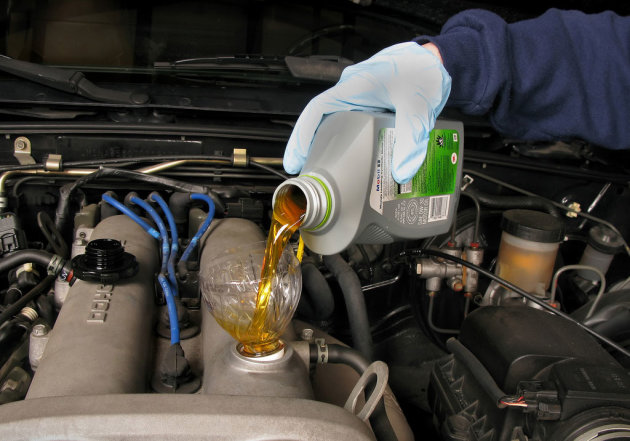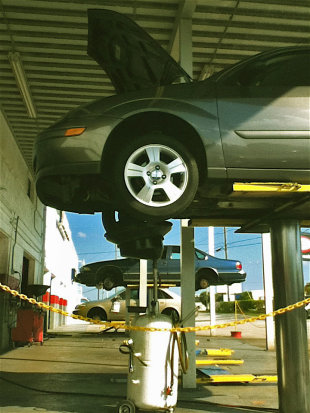AMSOIL Motorcycle Octane Boost
Maximizes Power and Efficiency
AMSOIL Motorcycle Octane Boost (MOB) increases octane for power and efficiency. It is designed to improve startup performance and eliminate engine ping and knock for increased power at low-rpm operation. Motorcycle Octane Boost contains detergents that help combustion chambers and fuel delivery systems maintain cleanliness for optimum performance. At the recommended treat rate, it does not harm catalytic converters or oxygen sensors and is compatible with all other AMSOIL fuel additives.
Maximizes Power & Performance
When treated at 1.3 oz. per gallon of fuel, MOB increases the octane of gasoline up to three numbers. Increased octane improves power and can eliminate performance-robbing and potentially damaging engine knock or ping (see below).
Motorcycle Octane Boost
Improves Low-rpm Performance
Engine knock is especially noticeable in some motorcycles during idle or low-rpm operation and high-temperature driving. Most modern bikes are equipped with sophisticated knock-detection systems that can alter spark timing and the air-to-fuel mixture until knock ceases. Although these systems protect the engine from damage, they can also cause reduced horsepower and poor low-rpm operability. AMSOIL MOB helps reduce the need for knock-detection systems to compensate, ensuring maximum low-rpm power and performance in modern bikes.
Cleans Harmful Deposits
Because Motorcycle Octane Boost contains active detergents, it can help maintain efficiency. For clean up, however, AMSOIL recommends treating gasoline with AMSOIL Quickshot®, which contains a greater concentration of cleaning agents.
What is engine knock and why does it matter?
The tendency of a hydrocarbon fuel, such as gasoline, to knock is measured by its octane number. Lower numbers denote a greater knock tendency; higher numbers denote greater knock control. “Engine knock” is a reference to the sound made from an uncontrolled and early ignition of fuel in the combustion chamber. It causes a knocking or pinging sound, robs the engine of power and can cause catastrophic engine damage. Knock may be eliminated by increasing the fuel’s octane.
What is Research Octane Number?
Research Octane Number (RON), Motor Octane Number (MON) and Anti-Knock Index (AKI) are the three most common octane ratings. AKI, the rating with which most North American motorists are familiar, is typically displayed on gas pumps as the average of the fuel’s RON and MON [(R+M)/2]. RON, however, is the most common industry rating. Therefore, AMSOIL uses the RON rating when conducting performance tests and product validation. Gasoline’s RON generally is a few numbers higher than the AKI posted on the gas pump (e.g. 87 octane fuel, or regular pump gas, has a RON of about 91-92).
Motorcycle Octane Boost
When marketing their products, some additive manufacturers have adopted a points system where 10 points equals one octane number. A claim that an additive increases octane 30 points translates into an increase of three octane numbers. This approach is often used only to artificially strengthen marketing claims and is not endorsed by AMSOIL.
Treat Rate
One 4-oz. bottle of AMSOIL Motorcycle Octane Boost treats four to six gallons of gasoline. Slight overtreatment causes no issues,
APPLICATIONS
Motorcycle Octane Boost is primarily recommended for use in four-stroke air- or liquid-cooled motorcycles manufactured by Harley-Davidson®, Yamaha®, Honda®, Ducati®, BMW®, Triumph® and all other four-stroke motorcycles. It may be used in off-road applications, including ATVs, UTVs and snowmobiles, as an alternative to AMSOIL DOMINATOR® Octane Boost. Note: Clean spills immediately using a clean towel. If left standing, Motorcycle Octane Boost can stain painted or metal surfaces. If cleaned immediately, there is no need for concern.
AMSOIL,Motorcycle,Octane,Boost,efficiency,performance,engine,operation,combustion,chambers,systems




 (Photo: JASON ANFINSEN/Flickr)
(Photo: JASON ANFINSEN/Flickr)

